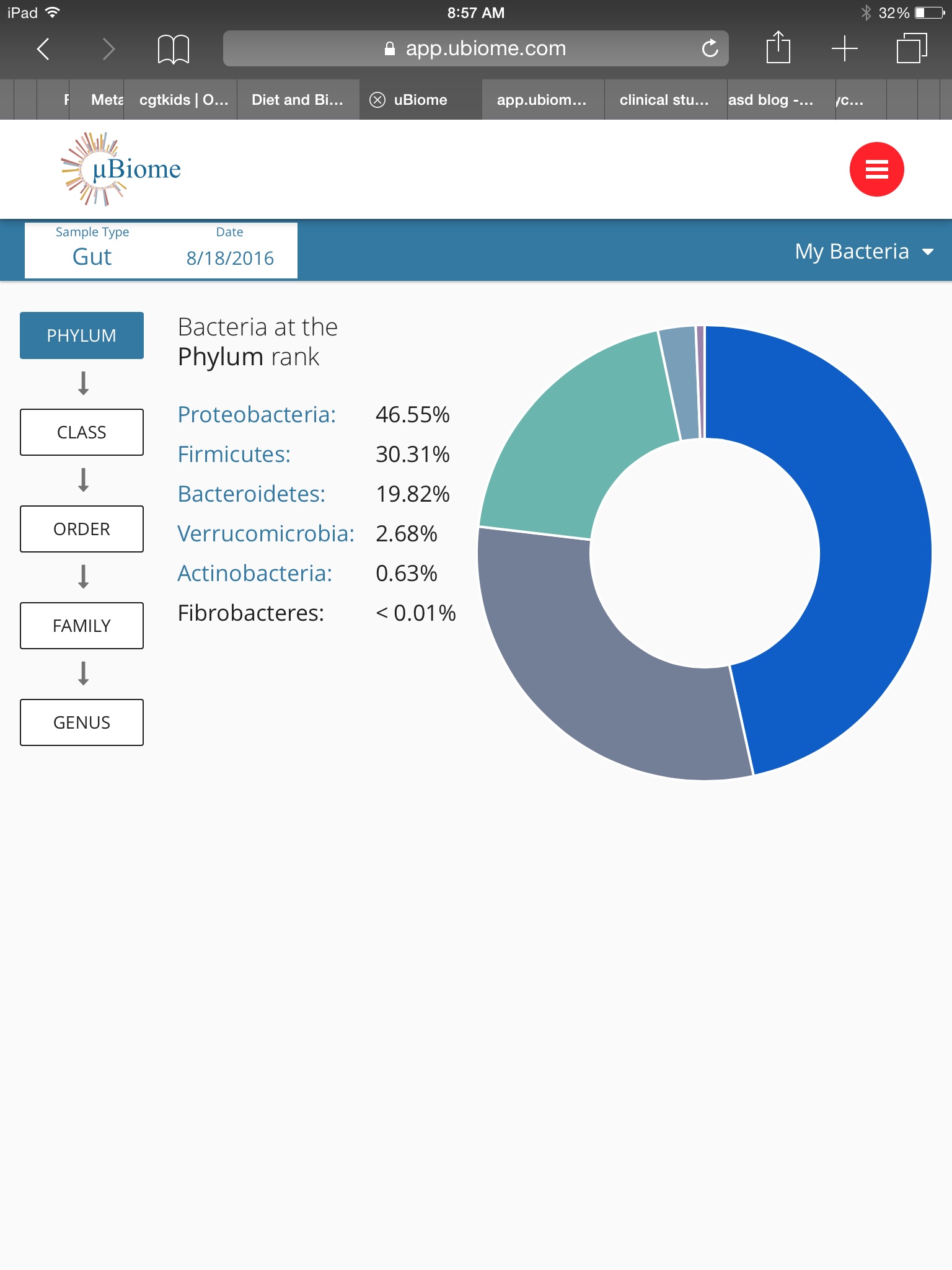Here are my daughter's Ubiome results. For her, certain foods trigger seizures. She has been on the Keto/MAD for the past 3 years. It has helped with the seizures, but I am really wanting to balance her gut flora, and I don't feel like this can be done while on such a low carb diet. The probiotic results section show that she has NO probiotic strains, but the overall bacterial load show much diveristy. Not exactly sure how to interpret this. Is there anything that stands out to anybody?
Bacteria at the
phylum rank
Firmicutes: 54.17%
Bacteroidetes: 39.88%
Proteobacteria: 4.00%
Actinobacteria: 1.74%
Verrucomicrobia: 0.16%
Lentisphaerae: 0.03%
Fibrobacteres: 0.02%
Cyanobacteria: < 0.01%
Bacteria at the
Class rank
Clostridia: 48.96%
Bacteroidia: 39.88%
Deltaproteobacteria: 3.54%
Erysipelotrichia: 2.05%
Bacilli: 1.81%
Actinobacteria: 1.74%
Negativicutes: 1.34%
Betaproteobacteria: 0.29%
Verrucomicrobiae: 0.16%
Gammaproteobacteria: 0.09%
Alphaproteobacteria: 0.09%
Lentisphaeria: 0.03%
Fibrobacteria: 0.02%
Bacteria at the
order rank
Clostridiales: 48.89%
Bacteroidales: 39.88%
Desulfovibrionales: 3.54%
Erysipelotrichales: 2.05%
Lactobacillales: 1.81%
Coriobacteriales: 1.69%
Selenomonadales: 1.34%
Burkholderiales: 0.28%
Verrucomicrobiales: 0.16%
Enterobacteriales: 0.09%
Rhodospirillales: 0.09%
Actinomycetales: 0.05%
Thermoanaerobacterales: 0.04%
Fibrobacterales: 0.02%
Rhodocyclales: < 0.01%
Bacillales: < 0.01%
Oscillatoriales: < 0.01%
Bacteria at the
family rank
Lachnospiraceae: 26.28%
Bacteroidaceae: 25.57%
Ruminococcaceae: 9.78%
Porphyromonadaceae: 9.21%
Clostridiaceae: 6.66%
Rikenellaceae: 5.07%
Desulfovibrionaceae: 3.54%
Erysipelotrichaceae: 1.95%
Lactobacillaceae: 1.75%
Coriobacteriaceae: 1.69%
Acidaminococcaceae: 1.26%
Peptostreptococcaceae: 1.16%
Oscillospiraceae: 0.81%
Clostridiales Family XIII. Incertae Sedis: 0.35%
Sutterellaceae: 0.17%
Verrucomicrobiaceae: 0.16%
Oxalobacteraceae: 0.11%
Enterobacteriaceae: 0.09%
Rhodospirillaceae: 0.09%
Veillonellaceae: 0.08%
Caldicoprobacteraceae: 0.08%
Peptococcaceae: 0.05%
Thermoanaerobacteraceae: 0.04%
Victivallaceae: 0.03%
Mycobacteriaceae: 0.03%
Actinomycetaceae: 0.02%
Fibrobacteraceae: 0.02%
Streptococcaceae: 0.01%
Catabacteriaceae: < 0.01%
Prevotellaceae: < 0.01%
Eubacteriaceae: < 0.01%
Micrococcaceae: < 0.01%
Bacteria at the
genus rank
Bacteroides: 25.53%
Blautia: 14.96%
Faecalibacterium: 7.01%
Sarcina: 5.68%
Alistipes: 5.01%
Barnesiella: 4.86%
Roseburia: 3.79%
Bilophila: 2.73%
Parabacteroides: 2.24%
Odoribacter: 1.73%
Pseudobutyrivibrio: 1.71%
Eggerthella: 1.38%
Lachnospira: 1.37%
Phascolarctobacterium: 1.26%
Intestinimonas: 1.22%
Moryella: 1.09%
Oscillospira: 1.05%
Fusicatenibacter: 1.01%
Erysipelatoclostridium: 0.89%
Flavonifractor: 0.88%
Desulfovibrio: 0.76%
Turicibacter: 0.64%
Eisenbergiella: 0.62%
Anaerotruncus: 0.56%
Intestinibacter: 0.48%
Subdoligranulum: 0.33%
Butyricimonas: 0.32%
Lactonifactor: 0.27%
Terrisporobacter: 0.24%
Gordonibacter: 0.19%
Clostridium: 0.18%
Dielma: 0.18%
Sutterella: 0.17%
Akkermansia: 0.16%
Oscillibacter: 0.15%
Holdemania: 0.13%
Herbaspirillum: 0.11%
Pseudoflavonifractor: 0.09%
Megasphaera: 0.08%
Peptoclostridium: 0.08%
Kluyvera: 0.08%
Dorea: 0.05%
Anaerostipes: 0.05%
Peptococcus: 0.05%
Asaccharospora: 0.04%
Gelria: 0.04%
Thalassospira: 0.03%
Collinsella: 0.03%
Marvinbryantia: 0.03%
Victivallis: 0.03%
Coprobacter: 0.02%
Actinomyces: 0.02%
Caldicoprobacter: 0.02%
Candidatus Soleaferrea: 0.02%
Fibrobacter: 0.02%
Anaerosporobacter: 0.01%
Streptococcus: 0.01%
Butyricicoccus: 0.01%
Anaerofilum: < 0.01%
Catabacter: < 0.01%
Klebsiella: < 0.01%
Romboutsia: < 0.01%
Shuttleworthia: < 0.01%
Coprobacillus: < 0.01%
Robinsoniella: < 0.01%
Senegalimassilia: < 0.01%
Epulopiscium: < 0.01%
Anaerofustis: < 0.01%
Hydrogenoanaerobacterium: < 0.01%
Kocuria: < 0.01%
Bacteria at the
phylum rank
Firmicutes: 54.17%
Bacteroidetes: 39.88%
Proteobacteria: 4.00%
Actinobacteria: 1.74%
Verrucomicrobia: 0.16%
Lentisphaerae: 0.03%
Fibrobacteres: 0.02%
Cyanobacteria: < 0.01%
Bacteria at the
Class rank
Clostridia: 48.96%
Bacteroidia: 39.88%
Deltaproteobacteria: 3.54%
Erysipelotrichia: 2.05%
Bacilli: 1.81%
Actinobacteria: 1.74%
Negativicutes: 1.34%
Betaproteobacteria: 0.29%
Verrucomicrobiae: 0.16%
Gammaproteobacteria: 0.09%
Alphaproteobacteria: 0.09%
Lentisphaeria: 0.03%
Fibrobacteria: 0.02%
Bacteria at the
order rank
Clostridiales: 48.89%
Bacteroidales: 39.88%
Desulfovibrionales: 3.54%
Erysipelotrichales: 2.05%
Lactobacillales: 1.81%
Coriobacteriales: 1.69%
Selenomonadales: 1.34%
Burkholderiales: 0.28%
Verrucomicrobiales: 0.16%
Enterobacteriales: 0.09%
Rhodospirillales: 0.09%
Actinomycetales: 0.05%
Thermoanaerobacterales: 0.04%
Fibrobacterales: 0.02%
Rhodocyclales: < 0.01%
Bacillales: < 0.01%
Oscillatoriales: < 0.01%
Bacteria at the
family rank
Lachnospiraceae: 26.28%
Bacteroidaceae: 25.57%
Ruminococcaceae: 9.78%
Porphyromonadaceae: 9.21%
Clostridiaceae: 6.66%
Rikenellaceae: 5.07%
Desulfovibrionaceae: 3.54%
Erysipelotrichaceae: 1.95%
Lactobacillaceae: 1.75%
Coriobacteriaceae: 1.69%
Acidaminococcaceae: 1.26%
Peptostreptococcaceae: 1.16%
Oscillospiraceae: 0.81%
Clostridiales Family XIII. Incertae Sedis: 0.35%
Sutterellaceae: 0.17%
Verrucomicrobiaceae: 0.16%
Oxalobacteraceae: 0.11%
Enterobacteriaceae: 0.09%
Rhodospirillaceae: 0.09%
Veillonellaceae: 0.08%
Caldicoprobacteraceae: 0.08%
Peptococcaceae: 0.05%
Thermoanaerobacteraceae: 0.04%
Victivallaceae: 0.03%
Mycobacteriaceae: 0.03%
Actinomycetaceae: 0.02%
Fibrobacteraceae: 0.02%
Streptococcaceae: 0.01%
Catabacteriaceae: < 0.01%
Prevotellaceae: < 0.01%
Eubacteriaceae: < 0.01%
Micrococcaceae: < 0.01%
Bacteria at the
genus rank
Bacteroides: 25.53%
Blautia: 14.96%
Faecalibacterium: 7.01%
Sarcina: 5.68%
Alistipes: 5.01%
Barnesiella: 4.86%
Roseburia: 3.79%
Bilophila: 2.73%
Parabacteroides: 2.24%
Odoribacter: 1.73%
Pseudobutyrivibrio: 1.71%
Eggerthella: 1.38%
Lachnospira: 1.37%
Phascolarctobacterium: 1.26%
Intestinimonas: 1.22%
Moryella: 1.09%
Oscillospira: 1.05%
Fusicatenibacter: 1.01%
Erysipelatoclostridium: 0.89%
Flavonifractor: 0.88%
Desulfovibrio: 0.76%
Turicibacter: 0.64%
Eisenbergiella: 0.62%
Anaerotruncus: 0.56%
Intestinibacter: 0.48%
Subdoligranulum: 0.33%
Butyricimonas: 0.32%
Lactonifactor: 0.27%
Terrisporobacter: 0.24%
Gordonibacter: 0.19%
Clostridium: 0.18%
Dielma: 0.18%
Sutterella: 0.17%
Akkermansia: 0.16%
Oscillibacter: 0.15%
Holdemania: 0.13%
Herbaspirillum: 0.11%
Pseudoflavonifractor: 0.09%
Megasphaera: 0.08%
Peptoclostridium: 0.08%
Kluyvera: 0.08%
Dorea: 0.05%
Anaerostipes: 0.05%
Peptococcus: 0.05%
Asaccharospora: 0.04%
Gelria: 0.04%
Thalassospira: 0.03%
Collinsella: 0.03%
Marvinbryantia: 0.03%
Victivallis: 0.03%
Coprobacter: 0.02%
Actinomyces: 0.02%
Caldicoprobacter: 0.02%
Candidatus Soleaferrea: 0.02%
Fibrobacter: 0.02%
Anaerosporobacter: 0.01%
Streptococcus: 0.01%
Butyricicoccus: 0.01%
Anaerofilum: < 0.01%
Catabacter: < 0.01%
Klebsiella: < 0.01%
Romboutsia: < 0.01%
Shuttleworthia: < 0.01%
Coprobacillus: < 0.01%
Robinsoniella: < 0.01%
Senegalimassilia: < 0.01%
Epulopiscium: < 0.01%
Anaerofustis: < 0.01%
Hydrogenoanaerobacterium: < 0.01%
Kocuria: < 0.01%

